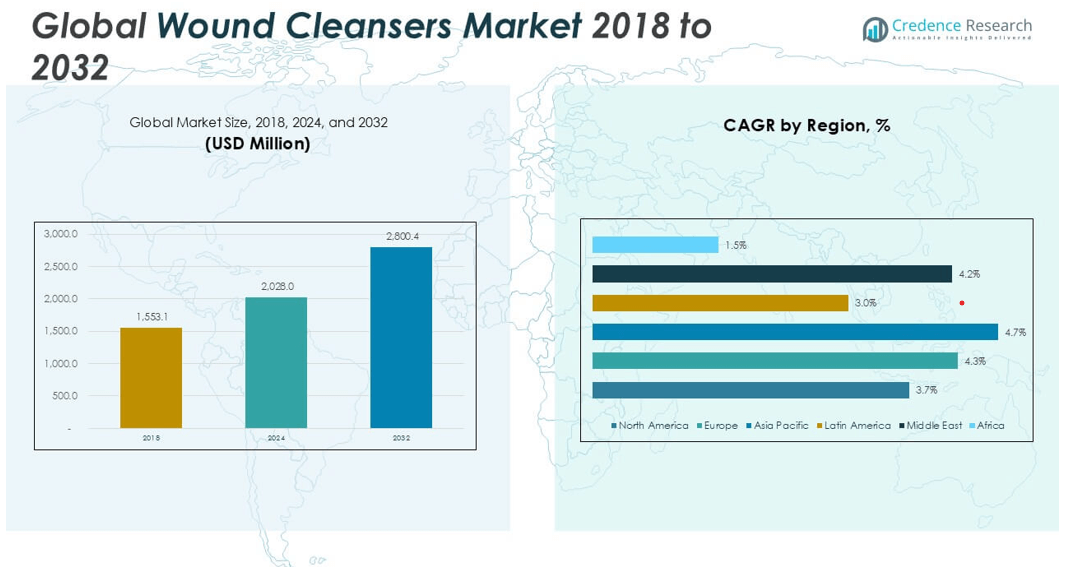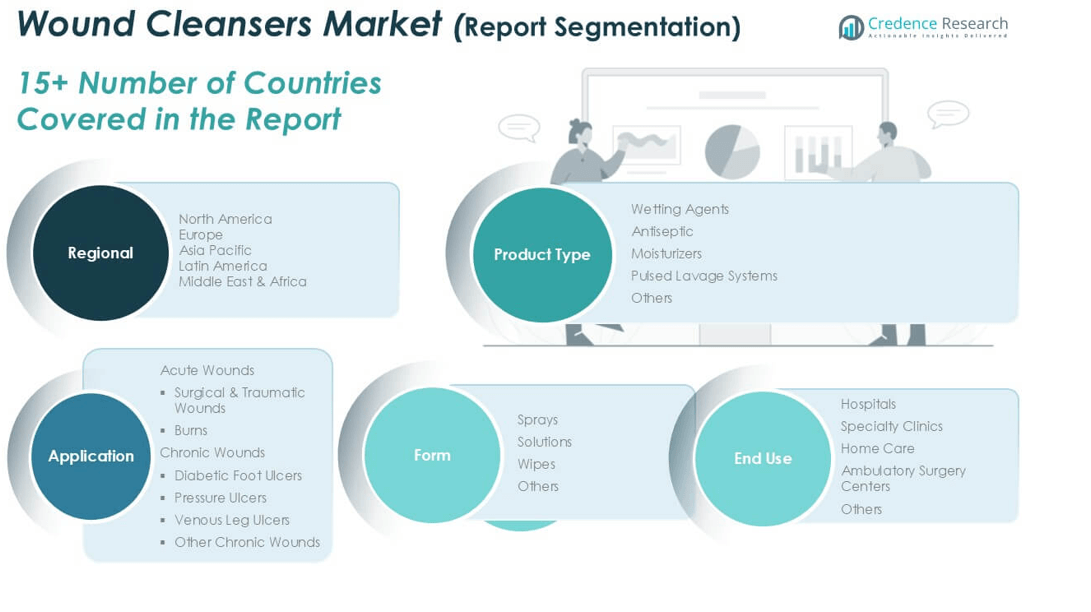CHAPTER NO. 1 : GENESIS OF THE MARKET
1.1 Market Prelude – Introduction & Scope
1.2 The Big Picture – Objectives & Vision
1.3 Strategic Edge – Unique Value Proposition
1.4 Stakeholder Compass – Key Beneficiaries
CHAPTER NO. 2 : EXECUTIVE LENS
2.1 Pulse of the Industry – Market Snapshot
2.2 Growth Arc – Revenue Projections (USD Million)
2.3. Premium Insights – Based on Primary Interviews
CHAPTER NO. 3 : WOUND CLEANSERS MARKET FORCES & INDUSTRY PULSE
3.1 Foundations of Change – Market Overview
3.2 Catalysts of Expansion – Key Market Drivers
3.2.1 Momentum Boosters – Growth Triggers
3.2.2 Innovation Fuel – Disruptive Technologies
3.3 Headwinds & Crosswinds – Market Restraints
3.3.1 Regulatory Tides – Compliance Challenges
3.3.2 Economic Frictions – Inflationary Pressures
3.4 Untapped Horizons – Growth Potential & Opportunities
3.5 Strategic Navigation – Industry Frameworks
3.5.1 Market Equilibrium – Porter’s Five Forces
3.5.2 Ecosystem Dynamics – Value Chain Analysis
3.5.3 Macro Forces – PESTEL Breakdown
3.6 Price Trend Analysis
3.6.1 Regional Price Trend
3.6.2 Price Trend by Product
CHAPTER NO. 4 : KEY INVESTMENT EPICENTER
4.1 Regional Goldmines – High-Growth Geographies
4.2 Product Frontiers – Lucrative Product Categories
4.3 End Use Sweet Spots – Emerging Demand Segments
CHAPTER NO. 5: REVENUE TRAJECTORY & WEALTH MAPPING
5.1 Momentum Metrics – Forecast & Growth Curves
5.2 Regional Revenue Footprint – Market Share Insights
5.3 Segmental Wealth Flow – Product Type, Application, Form & End Use Revenue
CHAPTER NO. 6 : TRADE & COMMERCE ANALYSIS
6.1. Import Analysis By Region
6.1.1. Global Wound Cleansers Market Import Revenue By Region
6.2. Export Analysis By Region
6.2.1. Global Wound Cleansers Market Export Revenue By Region
CHAPTER NO. 7 : COMPETITION ANALYSIS
7.1. Company Market Share Analysis
7.1.1. Global Wound Cleansers Market: Company Market Share
7.2. Global Wound Cleansers Market Company Revenue Market Share
7.3. Strategic Developments
7.3.1. Acquisitions & Mergers
7.3.2. New Product Launch
7.3.3. Regional Expansion
7.4. Competitive Dashboard
7.5. Company Assessment Metrics, 2024
CHAPTER NO. 8 : WOUND CLEANSERS MARKET – BY PRODUCT TYPE SEGMENT ANALYSIS
8.1. Wound Cleansers Market Overview By Product Type Segment
8.1.1. Wound Cleansers Market Revenue Share By Product Type
8.2. Wetting Agents
8.3. Antiseptic
8.4. Moisturizers
8.5. Pulsed Lavage Systems
8.6. Others
CHAPTER NO. 9 : WOUND CLEANSERS MARKET – BY APPLICATION SEGMENT ANALYSIS
9.1. Wound Cleansers Market Overview By Application Segment
9.1.1. Wound Cleansers Market Revenue Share By Application
9.2. Acute Wounds
9.2.1 Surgical & Traumatic Wounds
9.2.2. Burns
9.3. Chronic Wounds
9.3.1. Diabetic Foot Ulcers
9.3.2. Pressure Ulcers
9.3.3. Venous Leg Ulcers
9.3.4. Other Chronic Wounds
CHAPTER NO. 10 : WOUND CLEANSERS MARKET – BY FORM SEGMENT ANALYSIS
10.1. Wound Cleansers Market Overview By Form Segment
10.1.1. Wound Cleansers Market Revenue Share By Form
10.2. Sprays
10.3. Solutions
10.4. Wipes
10.5. Others
CHAPTER NO. 11 : WOUND CLEANSERS MARKET – BY END USE SEGMENT ANALYSIS
11.1. Wound Cleansers Market Overview By End Use Segment
11.1.1. Wound Cleansers Market Revenue Share By End Use
11.2. Hospitals
11.3. Specialty Clinics
11.4. Home Care
11.5. Ambulatory Surgery Centers
11.6. Others
CHAPTER NO. 12 : WOUND CLEANSERS MARKET – REGIONAL ANALYSIS
12.1. Wound Cleansers Market Overview By Region Segment
12.1.1. Global Wound Cleansers Market Revenue Share By Region
12.1.2. Regions
12.1.3. Global Wound Cleansers Market Revenue By Region
12.1.4. Product Type
12.1.5. Global Wound Cleansers Market Revenue By Product Type
12.1.6. Application
12.1.7. Global Wound Cleansers Market Revenue By Application
12.1.8. Form
12.1.9. Global Wound Cleansers Market Revenue By Form
12.1.10. End Use
12.1.11. Global Wound Cleansers Market Revenue By End Use
CHAPTER NO. 13 : NORTH AMERICA WOUND CLEANSERS MARKET – COUNTRY ANALYSIS
13.1. North America Wound Cleansers Market Overview By Country Segment
13.1.1. North America Wound Cleansers Market Revenue Share By Region
13.2. North America
13.2.1. North America Wound Cleansers Market Revenue By Country
13.2.2. Product Type
13.2.3. North America Wound Cleansers Market Revenue By Product Type
13.2.4. Application
13.2.5. North America Wound Cleansers Market Revenue By Application
13.2.6. Form
13.2.7. North America Wound Cleansers Market Revenue By Form
13.2.8. End Use
13.2.9. North America Wound Cleansers Market Revenue By End Use
13.3. U.S.
13.4. Canada
13.5. Mexico
CHAPTER NO. 14 : EUROPE WOUND CLEANSERS MARKET – COUNTRY ANALYSIS
14.1. Europe Wound Cleansers Market Overview By Country Segment
14.1.1. Europe Wound Cleansers Market Revenue Share By Region
14.2. Europe
14.2.1. Europe Wound Cleansers Market Revenue By Country
14.2.2. Product Type
14.2.3. Europe Wound Cleansers Market Revenue By Product Type
14.2.4. Application
14.2.5. Europe Wound Cleansers Market Revenue By Application
14.2.6. Form
14.2.7. Europe Wound Cleansers Market Revenue By Form
14.2.8. End Use
14.2.9. Europe Wound Cleansers Market Revenue By End Use
14.3. UK
14.4. France
14.5. Germany
14.6. Italy
14.7. Spain
14.8. Russia
14.9. Rest of Europe
CHAPTER NO. 15 : ASIA PACIFIC WOUND CLEANSERS MARKET – COUNTRY ANALYSIS
15.1. Asia Pacific Wound Cleansers Market Overview By Country Segment
15.1.1. Asia Pacific Wound Cleansers Market Revenue Share By Region
15.2. Asia Pacific
15.2.1. Asia Pacific Wound Cleansers Market Revenue By Country
15.2.2. Product Type
15.2.3. Asia Pacific Wound Cleansers Market Revenue By Product Type
15.2.4. Application
15.2.5. Asia Pacific Wound Cleansers Market Revenue By Application
15.2.6. Form
15.2.7. Asia Pacific Wound Cleansers Market Revenue By Form
15.2.8. End Use
15.2.9. Asia Pacific Wound Cleansers Market Revenue By End Use
15.3. China
15.4. Japan
15.5. South Korea
15.6. India
15.7. Australia
15.8. Southeast Asia
15.9. Rest of Asia Pacific
CHAPTER NO. 16 : LATIN AMERICA WOUND CLEANSERS MARKET – COUNTRY ANALYSIS
16.1. Latin America Wound Cleansers Market Overview By Country Segment
16.1.1. Latin America Wound Cleansers Market Revenue Share By Region
16.2. Latin America
16.2.1. Latin America Wound Cleansers Market Revenue By Country
16.2.2. Product Type
16.2.3. Latin America Wound Cleansers Market Revenue By Product Type
16.2.4. Application
16.2.5. Latin America Wound Cleansers Market Revenue By Application
16.2.6. Form
16.2.7. Latin America Wound Cleansers Market Revenue By Form
16.2.8. End Use
16.2.9. Latin America Wound Cleansers Market Revenue By End Use
16.3. Brazil
16.4. Argentina
16.5. Rest of Latin America
CHAPTER NO. 17 : MIDDLE EAST WOUND CLEANSERS MARKET – COUNTRY ANALYSIS
17.1. Middle East Wound Cleansers Market Overview By Country Segment
17.1.1. Middle East Wound Cleansers Market Revenue Share By Region
17.2. Middle East
17.2.1. Middle East Wound Cleansers Market Revenue By Country
17.2.2. Product Type
17.2.3. Middle East Wound Cleansers Market Revenue By Product Type
17.2.4. Application
17.2.5. Middle East Wound Cleansers Market Revenue By Application
17.2.6. Form
17.2.7. Middle East Wound Cleansers Market Revenue By Form
17.2.8. End Use
17.2.9. Middle East Wound Cleansers Market Revenue By End Use
17.3. GCC Countries
17.4. Israel
17.5. Turkey
17.6. Rest of Middle East
CHAPTER NO. 18 : AFRICA WOUND CLEANSERS MARKET – COUNTRY ANALYSIS
18.1. Africa Wound Cleansers Market Overview By Country Segment
18.1.1. Africa Wound Cleansers Market Revenue Share By Region
18.2. Africa
18.2.1. Africa Wound Cleansers Market Revenue By Country
18.2.2. Product Type
18.2.3. Africa Wound Cleansers Market Revenue By Product Type
18.2.4. Application
18.2.5. Africa Wound Cleansers Market Revenue By Application
18.2.6. Form
18.2.7. Africa Wound Cleansers Market Revenue By Form
18.2.8. End Use
18.2.9. Africa Wound Cleansers Market Revenue By End Use
18.3. South Africa
18.4. Egypt
18.5. Rest of Africa
CHAPTER NO. 19 : COMPANY PROFILES
19.1. Solventum
19.1.1. Company Overview
19.1.2. Product Portfolio
19.1.3. Financial Overview
19.1.4. Recent Developments
19.1.5. Growth Strategy
19.1.6. SWOT Analysis
19.2. B. Braun Melsungen AG
19.3. Cardinal Health, Inc.
19.4. Church & Dwight Inc.
19.5. Coloplast A/S
19.6. ConvaTec Group Plc
19.7. Molnlycke Health Care AB
19.8. Integra LifeSciences
19.9. Medline Industries, Inc.
19.10. Smith+Nephew
19.11. Derma Sciences, Inc.
19.12. Innovacyn, Inc.
19.13. Mundipharma International Ltd.
19.14. NovaBay Pharmaceuticals, Inc.
19.15. Schulke & Mayr GmbH
19.16. Other Key Players





